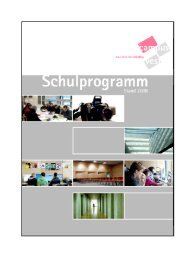NewScientist.com news service - Max-Born-Berufskolleg
NewScientist.com news service - Max-Born-Berufskolleg
NewScientist.com news service - Max-Born-Berufskolleg
Create successful ePaper yourself
Turn your PDF publications into a flip-book with our unique Google optimized e-Paper software.
Space elevators to heave themselves skyward<br />
20:07 16 October 2006<br />
<strong>NewScientist</strong>.<strong>com</strong> <strong>news</strong> <strong>service</strong><br />
Kelly Young<br />
Enlarge image<br />
A crane-mounted ‘racetrack’ was used for NASA's 2005 climber <strong>com</strong>petition (Image: Spaceward Foundation)<br />
A few early prototypes for space elevators will try to get off the ground at a <strong>com</strong>petition at the Wirefly X<br />
Prize Cup in Las Cruces, New Mexico, US, on 20 and 21 October.<br />
The hope is that one day a space elevator, <strong>com</strong>prised of a robot that will climb a strong tether about<br />
100,000 kilometres (60,000 miles) long, will be able to send humans or other cargo cheaply into space.<br />
To spur the development of that technology, NASA set up two annual <strong>com</strong>petitions, called the Power<br />
Beaming and Tether Challenges. The first <strong>com</strong>petitions were held in 2005 – but no one won either of<br />
them (see Space elevators stuck on the first floor).<br />
In the Beam Power Challenge, teams have to send a robotic climber up a crane-mounted tether at a<br />
minimum speed of one metre per second. The climbers will be judged by their speed and weight, with<br />
the top three teams taking home $150,000, $40,000 and $10,000, respectively.<br />
The catch is they cannot be powered by fuel, batteries or an electrical extension cord because a real<br />
space elevator could not carry these things on a trip into space. So the robotic climbers must use solar<br />
arrays powered by light sent from the Sun, solar reflectors, a spotlight, lasers or microwaves.<br />
A dozen teams will <strong>com</strong>pete in the climber challenge. About six to eight teams may have hardware that<br />
could climb all the way to the top, says Ben Shelef, co-founder of the Spaceward Foundation, a space<br />
advocacy group in Mountain View, California, US, which administers the <strong>com</strong>petition. Two to three of<br />
those could nab the prize money.<br />
Laser source<br />
New scientist from 16. october 2006
In 2005, teams had to use a spotlight that was provided for the <strong>com</strong>petition. This year, they can bring<br />
their power source.<br />
A Canadian team from the University of Saskatchewan, which climbed to a record 12 metres (40 feet)<br />
in last year's <strong>com</strong>petition, says it is developing a laser power source for its climber.<br />
The laser will probably not be ready in time for the <strong>com</strong>petition, so the team will rely on a powerful<br />
search light instead. The spotlight may be cheaper in the short term, but in the long term, using energy<br />
beamed from a laser may be a more efficient way to move a space elevator, it says.<br />
If they had been able to use a laser this year, they had planned to climb 61 metres (200 feet), to the top<br />
of the tether. Now, they believe they may only reach half that height. "We're kind of thinking we might<br />
not be ready this year," says team president Clayton Ruszkowski. "I'm hoping for 100 feet."<br />
Steve Jones, captain of a team from the University of British Columbia in Canada, says his team's<br />
climber is light enough that it does not need a concentrated beam source, like a laser. Instead, it can<br />
run on either the Sun or a spotlight.<br />
"We're pretty sure we can win with either," Jones told New Scientist. Indeed, his team was voted most<br />
likely to win in 2006.<br />
Breaking point<br />
The related Tether Challenge aims to spark the development of lightweight materials strong enough to<br />
stretch 100,000 kilometres into space without breaking. Space elevator proponents believe a thin rope<br />
of carbon nanotubes will ultimately be needed for the task.<br />
For the challenge, 2-metre-long tethers are wrapped in loops and stretched to the breaking point. The<br />
tether cannot weigh more than 2 grams and must carry 50% more weight before breaking than the best<br />
tether from the previous year.<br />
Three teams will test their tethers' strength this year, including a group from the University of British<br />
Columbia. This year, they are using a tether made of Zylon fibres, which were once used in bulletproof<br />
vests. To maximise the material's strength, the team experimented with fabrication methods such as<br />
whether to tie the ends of the fibres or loop them.<br />
The <strong>com</strong>petitions will be held annually until 2010, so even if no one wins them this year, either, the<br />
<strong>com</strong>petitors can try again: "We're definitely just going to keep going and see what we can do for next<br />
year," Jones says.<br />
New scientist from 16. october 2006














